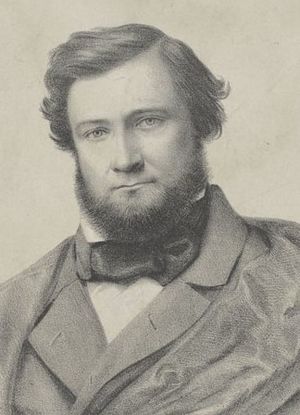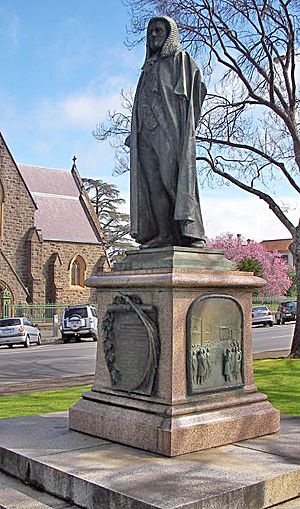Peter Lalor facts for kids
Quick facts for kids
Peter Lalor
|
|
|---|---|

The Hon. Peter Lalor MLA, Speaker of the Legislative Assembly of Victoria, 1880–1887
|
|
| Born | February 5, 1827 Raheen, Laois, Ireland
|
| Died | February 9, 1889 died at his sons house Melbourne, Victoria
|
| Cause of death | Died from diabetes |
| Known for | Leading the Eureka Rebellion, in which many Australians believe was the kick-starter to Australia's Democratic government |
| Successor | Sir Charles Gavan Duffy |
| Spouse(s) | Alicia Dunne |
| Children | Annie "Anne" Lalor, Joseph Lalor |
| Parent(s) | Ann, nèe Dillon, Patrick "Patt" Lalor |
| Relatives | James Fintan Lalor, Richard Lalor, William A. Lalor Snr., Margarett Ellen Lalor, Joseph Lalor, Thomas Lalor, Jerome Lalor, Patrick Lalor, Mary Lalor, John Lalor, Catherine Lalor |
Peter Lalor (born February 5, 1827 – died February 9, 1889) was a very important person in Australian history. He led the Eureka Stockade, which was a protest by gold miners. Many people believe this event helped start democracy in Australia. Later, he became an important politician in Victoria.
Peter Lalor left Ireland in 1852 with his brother, Richard. They came to Victoria, Australia, hoping to find gold and a better life. They first helped build the railway between Melbourne and Geelong. In 1853, Peter went to the Ovens River to look for gold. Richard went back to Ireland and became a member of parliament. Peter Lalor tried selling wine and tobacco in Melbourne, but then decided to go to Ballarat in 1854 to search for gold. He set up his camp at Eureka Lead, in East Ballarat, where many Irish miners lived.
Contents
Early Life and Move to Australia
Peter Lalor was born in 1827 in a place called Tenakill, in Ireland. He came from a large family that was often involved in Irish politics. His father, Patrick, was even a member of the British Parliament. Peter studied in Dublin and became a civil engineer, which means he designed and built things like roads and bridges.
Three of Peter's brothers moved to America and fought in the American Civil War. But Peter and his brother Richard chose to come to Australia. They arrived in Victoria in October 1852.
Lalor first worked on building the Melbourne–Geelong railway line. But he soon left that job to join the Victorian Gold Rush. He started mining for gold in the Ovens area, near Beechworth. Later, he moved to the Eureka Lead in Ballarat. There, he became friends with Duncan Gillies, who later became the leader of Victoria. His brother Richard went back to Ireland and became a politician there.
The Eureka Stockade
In 1854, many miners on the goldfields were very upset. They were angry about the high cost of a gold mining license and how the police treated them. In Ballarat, the miners started a group called the Ballarat Reform League. They wanted the government to change the laws. Peter Lalor became the chairman of this group.
After a very harsh search for licenses on November 30, 1854, the miners gathered at Bakery Hill. They wanted the League to protect them from police violence. Since the usual speakers were not there, Peter Lalor stepped forward. He gave a powerful speech that inspired everyone. The rebel miners then raised their new Eureka Flag.
Lalor made the miners promise to protect each other, their rights, and their freedom. He told them to get weapons and be ready if the police or government soldiers attacked. Peter Lalor became the new leader of the League. They quickly built a small fort, or stockade, at Eureka in east Ballarat.
This fort, known as the Eureka Stockade, was attacked by 275 government soldiers. The attack happened early in the morning on December 3, 1854, at 3:00 am. Twenty-two miners were killed, and Lalor was badly hurt. His friends hid him from the soldiers, and he managed to escape. Sadly, his left arm had to be removed.
Lalor's Political Career
After the Eureka Stockade, Peter Lalor was hidden in Geelong until the police stopped looking for him. The government then changed some laws. Miners on the goldfields were given the right to elect people to Parliament. In November 1855, Lalor was elected to Parliament.
As part of these democratic changes, Victoria received its own constitution in 1856. Lalor was elected to the new Parliament again. Over time, his political ideas changed. He became less focused on the miners' demands for everyone to have the right to vote. He also became involved in managing several mining companies.
In January 1871, Lalor lost his seat in an election. He then became the Chairman of the Clunes Water Commission, working to get water for the town of Clunes. He was voted back into parliament in 1874. In 1875, he became the Postmaster General, which meant he was in charge of the postal service. Later, he became the Commissioner for Trade and Customs.
From 1880 to 1887, he served as the Speaker of the Legislative Assembly. This is a very important role, like being the referee in parliament. Lalor's wife and daughter died in 1887. He was also sick with diabetes. Because of this, he stopped being Speaker but continued to represent the South Grant area in Parliament until he died.
Later Life and Death
Peter Lalor married Alicia Dunne on July 10, 1855, in Geelong. They had a daughter, Anne (Annie), born in Prahran in 1856. Their son, Joseph, was born in Sandridge (now called Port Melbourne) on December 18, 1857. Annie Lalor married Thomas Lempriere in 1882 but sadly died three years later from a lung illness. Joseph Lalor became a medical doctor. He married Agnes McCormick from Dublin, Ireland, and had children.
Alicia Lalor died on May 17, 1887, when she was 55 years old. After her death, Peter Lalor took a break from Parliament and visited San Francisco, California.
Lalor died on Saturday, February 9, 1889, at the age of 62. He passed away at his son's home in Richmond and was buried at the Melbourne General Cemetery.
Lalor's Legacy

A statue of Peter Lalor was put up in Sturt Street, Ballarat, in 1893. It was given to the city by his friend, James Oddie. Another friend, the Premier Duncan Gillies, officially revealed the statue.
The Melbourne suburb of Lalor, Victoria, was named after him in 1945. The suburb's name was originally said as "LAW-luh," like Peter Lalor's name. Even though many people still say it that way, "LAY-lor" has become more common recently.
Peter Lalor Vocational College (which used to be Peter Lalor Secondary College), located in the Lalor area, is named in his honor.
A federal voting area in the south-western suburbs of Melbourne, called the Division of Lalor, was named after him in 1948. Important Labor politicians like Reg Pollard, Jim Cairns, Barry Jones, and Julia Gillard have represented this area. The suburb of Lalor is not actually in this voting area.
Lalor Street in Ballarat East was also named to honor him.
The University of Ballarat (now called Federation University Australia) honored him by naming one of their student dorms after him. The other dorm was named after Bella Guerin, the first woman to graduate from an Australian university.
Peter Lalor's role in the Eureka Rebellion has been shown in several films. The first film where Lalor is thought to have appeared was Eureka Stockade (1907 film), but only a small part of it still exists. In 1915, Leslie Victor played Lalor in the silent film The Loyal Rebel, which is now considered a lost film. Later, Chips Rafferty played him in the 1949 British film Eureka Stockade. Australian actor Bryan Brown played Lalor in Eureka Stockade, a two-part TV mini-series from 1984. The most recent film to show Lalor was the Australian documentary Riot or Revolution: Eureka Stockade 1854 from 2006, where Andrew Larkins played him.
For more information about films showing Peter Lalor, you can see: Eureka Rebellion#Film and television.
Lalor has also been shown in the "Blood Under the Southern Cross" light and sound show at Sovereign Hill since 1992.
A fun statue, called a bollard, made by artist Jan Mitchell, shows Peter Lalor holding the Eureka flag. It was put up on the Geelong foreshore in 1999 as part of the Waterfront Geelong bollard walk.
His picture is on two special postage stamps. One is a 38c Ireland stamp released in 2001 as part of the "Rebel Spirit, Irish Heritage of Australia" series. The other is a 2004 AUD2.45 Australian stamp celebrating the Eureka Stockade.
Images for kids




